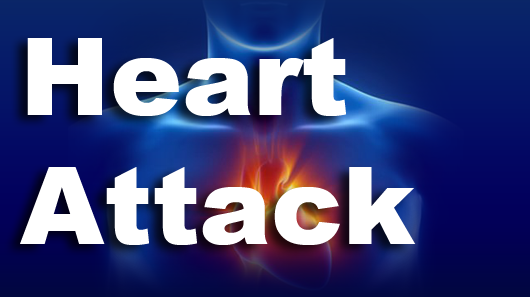Heart Attack
 |
Heart Attack
More than one million Americans have a heart attack each year. Those who do not seek or receive medical help usually die. Due to advances in medical technology, most heart attacks can be successfully treated if immediate medical help is provided.
Heart Attack Symptoms
- Severe chest pain or pressure - often spreading to arms, neck back and jaw area. This pain is usually prolonged, lasting from 30 minutes to several hours. Resting does not stop the pain or provide much relief, nor does changing the position of the body.
- Indigestion
- Nausea
- Sweating
- Dizziness
- Shortness of breath
Some people do not feel any chest pain during a heart attack; this is especially true of diabetic people and those over the age of 75.
If you suspect someone may be having a heart attack, do not wait to get help. Call 9-1-1 or your local emergency number immediately to request emergency medical services; do not transport the victim yourself unless emergency medical services are delayed.
Sudden Cardiac Arrest
A heart attack may cause suddent cardiac arrest. Cardiac arrest occurs when the heart stops pumping blood to the organs of the body. It takes approximately 10 seconds after cardiac arrest for a person to lose consciousness; they will not be roused by shaking or shouting.
The Chain of Survival
There are five links in the SCA Chain of Survival:
- Recognize cardiac arrest immediately and activate EMS. If a person is not responsive and is not breathing, call 9-1-1 or your local emergency number.
- Start CPR. After activating EMS, begin chest compressions. The American Heart Association recommends that all rescuers, regardless of training or skill level, should provide chest compressions to all cardiac arrest victims. Learn more about Hands-Only CPR here.
- Use a defibrillator (if available). Most victims of SCA need an electric shock called defibrillation to restore the heart to a regular rhythm. Using an automated external defibrillator (AED), when available, has shown a nearly 50% survival rate when an AED is deployed and used quickly.
- Early Advanced Life Support. Early advanced life support is the fourth link in the chain of survival. Paramedics and other EMS personnel provided early advanced life support, and this ensures that a cardiac arrest victim receives basic life support, defibrillation, administration of cardiac drugs and insertion of breathing tubes (intubation) as needed on the way to the hospital.
- Integrated post-cardiac arrest care.
Following the Chains of Survival dramatically increased the survival rates for Cardiac Arrest Victims:
- CPR and AED used within 8 minutes: 20% chance of survival.
- CPR and AED within 4 minutes/EMS within 8 minutes: 40% chance of survival.
- Defibrillation with 5 to 7 minutes: 49% survival rate.
Survival rates (revival with no permanent neurological damage) as high as 64% (9 out of 14) have been reported after AED's were placed at Chicago's O'Hare Midway Airports. Survival rates between 70 and 89% have been reported at U.S. high schools with AEDs.
If nothing is done for a cardiac arrest victim, he is probably going to die. Defibrillation applied shortly after collage gives a SCA victim a fair chance of survival.
| Back: Introduction |
Next: Stroke |

